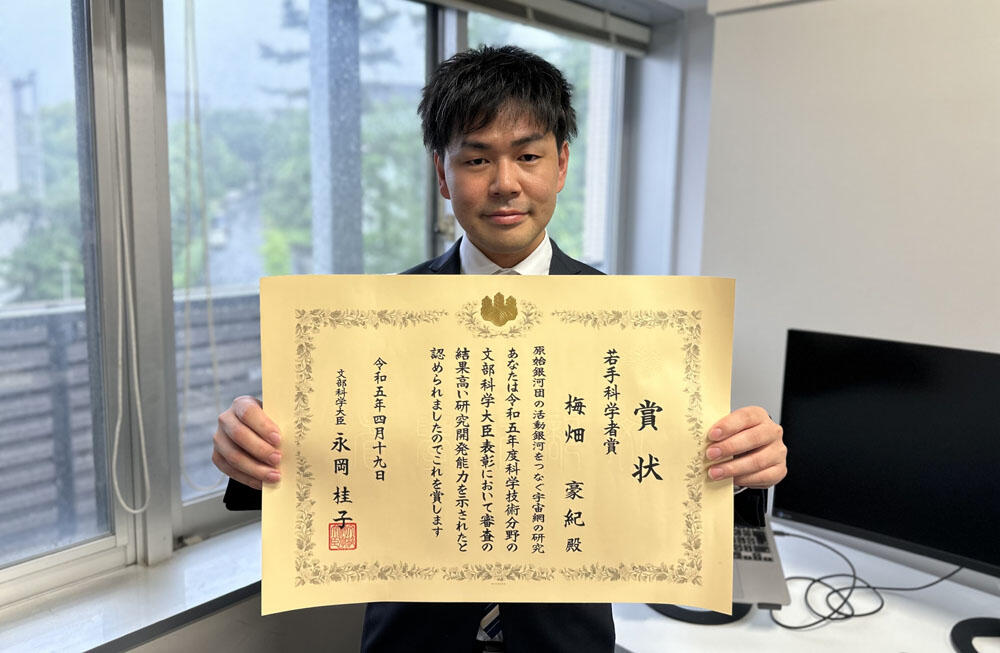Two up-and-coming astronomers received the Young Scientists' Award of the 2023 Commendations for Science and Technology by the Ministry of Education, Culture, Sports, Science and Technology (MEXT) for their observational research using the Subaru Telescope. The award winners are Dr. Hideki Umehata (Assistant Professor in Nagoya University) and Dr. Yuichi Harikane (Assistant Professor in the University of Tokyo).
The Young Scientists' Award is awarded to researchers under the age of 40 (or 42 if the researcher has been unable to devote himself/herself to research for a period of time due to childbirth or childcare) who have made outstanding research achievements. Dr. Umehata was recognized for his "research on the cosmic web filaments linking active galaxies in a protocluster," while Dr. Harikane was awarded for his "research on distant galaxies using large observational datasets from the Subaru Telescope and other telescopes."
Dr. Umehata has been conducting observations using the Subaru Telescope and the Atacama Large Millimeter/submillimeter Array (ALMA), to investigate the formation and evolution of galaxies and supermassive black holes at nodes of the large-scale structure of the Universe 11.5 billion years ago. In particular, using the wide-field camera Suprime-Cam on the Subaru Telescope, he discovered an extensive structure of hydrogen gas connecting massive galaxies and supermassive black holes, confirming the existence of "cosmic web" filaments that had long been predicted by theory and simulations (Note 1). These results suggest that gas supply through the cosmic web plays a crucial role in fueling the high activity of massive galaxies and supermassive black holes in the early Universe.

Figure 1: Dr. Hideki Umehata (Assistant Professor in Nagoya University), who received the Young Scientists’ Award. (Credit: Nagoya University)
"I am thrilled and honored to receive such a wonderful award," Dr. Umehata says. "I would like to take this opportunity to express my gratitude to all those who have been involved in this research, including my fellow collaborators. In this study, data obtained by Suprime-Cam played a significant role in the discovery of the cosmic web. Now, using its successor, Hyper Suprime-Cam (HSC), we are exploring larger structures in the cosmic web. With the upcoming launch of PFS (Prime Focus Spectrograph) and leveraging the strengths of the Subaru Telescope, I aspire to continue advancing studies of the early Universe."
Dr. Harikane has focused on observational research of distant galaxies and led the analysis of large observational datasets from the Subaru Telescope to construct the world's largest sample of distant galaxies, consisting of 4 million objects, in the Universe 10 to 13 billion years ago, which had not been previously studied in detail. He also answered the long-standing question as to the physical origins of the star formation history of the entire Universe and identified a primordial galaxy cluster 13 billion years ago, the farthest on record at the time (Note 2). While making several important discoveries, he has led the field of distant galaxy observation. He has also led teams of international researchers and has been awarded multiple observing times on competitive telescopes such as NASA's James Webb Space Telescope's first-year operations program and ALMA.

Figure 2: Dr. Yuichi Harikane (Assistant Professor in the University of Tokyo), who received the Young Scientists’ Award. (Credit: Institute for Cosmic Ray Research, the University of Tokyo)
On receiving the award, Dr. Harikane says, "I am honored to receive such a prestigious award this time. The research using Hyper Suprime-Cam (HSC) on the Subaru Telescope, which is recognized by the award, could not have been realized without the support of the researchers at NAOJ, who have contributed to the development and operation of HSC and the Subaru Telescope. I would like to express my gratitude to all of my co-researchers and all those involved with the Subaru Telescope and HSC. I look forward to further developing our research with PFS. I hope to have fun leading cutting-edge research projects."
Dr. Harikane comments on the role of the Subaru Telescope in their study of the early Universe, "The Subaru Telescope is equipped with unique wide-field cameras that are not found on other 8-meter-class telescopes. Thanks to their wide-field capabilities, both Dr. Umehata and I have succeeded in constructing an overwhelmingly large sample of galaxies, discovering a rare primitive galaxy cluster, and exploring the cosmic web in the early Universe. From such observations, we found that the relationship between galaxies and gas in the large-scale structure of the Universe has played an important role in the formation and evolution of galaxies. Looking ahead, we have high expectations that observations with the upcoming PFS, as well as the next-generation Thirty Meter Telescope, will reveal the physical properties of individual galaxies and shed light on the formation of galaxies in the early Universe."
(Note 1) Massive Filaments Fuel the Growth of Galaxies and Supermassive Black Holes (Subaru Telescope October 3, 2019 Press Release)
(Note 2) Oldest Galaxy Protocluster forms "Queen's Court" (Subaru Telescope September 26, 2019 Press Release)


